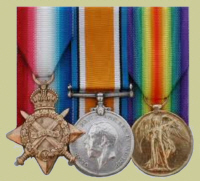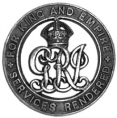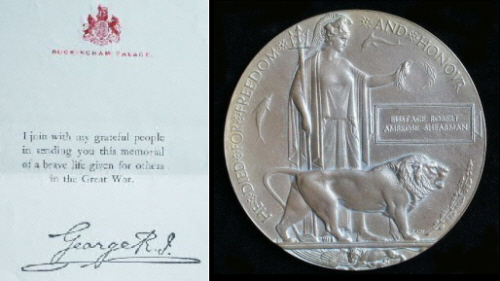

OLD CONTEMPTIBLES
5th August to 22nd November 1914
PIP, SQUEAK and WILFRED

|
1914 STAR..."PIP" A bronze medal, about 378,000 were issued to those who served in France or Belgium between 5 August and 22 November 1914. Mainly Regulars or Territorials, a few land based Navy, and a few Australian and Canadians were the recipients. The central scroll carries the dates for the 1914 Star, or 1914-15 for the 14-18 Star. The 1914-1915 Star was awarded to personnel who served in Gallipoli, but they could not have been awarded the 1914 Star BRITISH WAR MEDAL..."SQUEAK" A solid silver medal was awarded for service between 1914 and 1920 in any of the services or the Crown and Colonies and some civilian organisations. About 6 million were issued, plus around 110,000 in bronze for native personnel in various labour corps. VICTORY MEDAL 1914-1920...WILFRED A bronze medal, awarded to those who had received the 1914 or 1914-15 Star, and to most who had received the War Medal, it could not be awarded alone. Those having service in a war theatre and various civilians in recognised voluntary organisations received the award. Those Mentioned in Despatches wore a bronze oak leaf on the ribbon. Some 5,750,000 were issued. Pip,Squeak and Wilfred were awarded to around 2.5 million, whereas the pair without the 1914 , or 1914-15 Star were awarded to 3.2 million and are commonly known as MUTT and JEFF. As the British War Medal was of solid silver, sets can be harder to find now as many families sold the more valuable medal when times were hard. The Star and Victory Medal were never issued without the British War Medal. If you find this pair alone it can only mean the silver British War Medal has been lost or otherwise disposed of. OLD CONTEMPTIBLES Legend has it that the Kaiser, in his Headquarters, addressed his Generals on 22nd November in words along the lines of:- "It is my Royal and Imperial command that you concentrate your energies for the immediate present upon one single purpose, and that is that you address your skill and all the valour of my soldiers to exterminate the treacherous English, and walk over General French's contemptibly small army". Naturally, being British, the members of General French's Expeditionary Force were delighted from then on to adopt the title of "Old Contemptibles" The term though, and membership of their Association, hung on these two dates and the days between. Service in other theatres of war at that time did not count either, the Old Contemptible had to have been in France or Belgium between those dates.
The last Old Contemptible, Alfred Anderson, died in 2005, aged 109. The Old Contemptibles Associations (first formed in 1925) had all been disbanded by then. Some of the men here were very definitely Old Contemptibles, dying during those very early days. Perhaps records will indicate which others qualified. The loss of so many Service Records during the Blitz of WW2 will not help this task but luckily many medal cards are still available. Here is an example of a Medal Card, clearly signifying that George had come under fire between 5th August 1914 and 22nd November 1914
|

|
The Silver War Badge was issued in the United Kingdom to service personnel who had been honourably discharged due to wounds or sickness during World War I.
The badge, sometimes known as the Discharge Badge, Wound Badge or Services Rendered Badge, was first issued in September 1916, along with an official
certificate of entitlement. The sterling silver lapel badge was intended to be worn in civilian clothes. It had been the practice of some women to present
white feathers to apparently able-bodied young men who were not wearing the King's uniform. The badge was to be worn on the right breast while in civilian
dress, it was forbidden to wear on a military uniform. The badge bears the royal cipher of GRI (for Georgius Rex Imperator; George, King and Emperor) and around the rim "For King and Empire; Services Rendered". Each badge was uniquely numbered on the reverse. The War Office made it known that they would not replace Silver War Badges if they went missing, however if one was handed into a police station then it would be returned to the War Office. If the original recipient could be traced at his or her discharge address then the badge would be returned. A very similar award, known as the King's Badge, was issued in World War II. Although each was accompanied by a certificate, issues of this latter award were not numbered. |

In 1916 It was decided that some form of memorial would be established for presentation to the next of kin of those that died during the war. A government
committee was established to decide the nature of this memorial, and in August 1917 it was determined that it would take the form of a bronze plaque,
the design of which would be decided by a public competition with a winning prize of £250. The winner was Edward Carter Preston, whose now familiar 4 ¾ inches
diameter (121 mm) "Memorial Plaque" is illustrated above. The name of the casualty is cast in the oblong on the right of the plaque, with no number or rank, or unit
Production of the Plaque began in December 1918 at Acton in west London, later transferring to the Woolwich Arsenal and other munitions factories .
Over a million were produced, commemorating the sacrifice of men and women who died between the 4th August 1914 and 30th April 1920.
From 1919 and for several years after the end of the Great War there were over 1,000,000 plaques and scrolls sent to next of kin in commemoration of their
soldiers, sailors, airmen and a few hundred women who died as a direct consequence attributable to service in the Great War. All those who died between 4th
August 1914 and 30th April 1919 whilst in military service in the battlegrounds of the theatres of war and in the Dominions, as a result of sickness,
suicide or accidents in the Home Establishments, or as a result of wounds incurred during their time in military service were commemorated on a plaque and a
scroll.
The next of kin of the 306 British and Commonwealth military personnel who were executed following a Court Martial did not receive a memorial plaque.
The circular shape and coin-like appearance soon contributed to the nickname of this memorial plaque becoming widely known as the “Dead Man's Penny”, the
“Death Penny”, “Death Plaque” or “Widow's Penny”. Approximately 600 memorial plaques were issued to the next of kin of women who died as a direct consequence
of their involvement in the Great War. In these cases the motto on the plaques was amended to “She died for freedom and honour”.
World War Two medals
Unfortunately the medal ribbon can not be displayed for all the WW2 men since their records are not available to the public.Various qualification times for
most campaign medals means that unless a relative actually comes up with the medals, qualifications cannot be worked out. Hopefully when this website is more complete and the WW2 medals awarded are known
, images and details can be added here. The award of the Defence Medal in particular is confusing. All gallantry awards however will be
displayed.